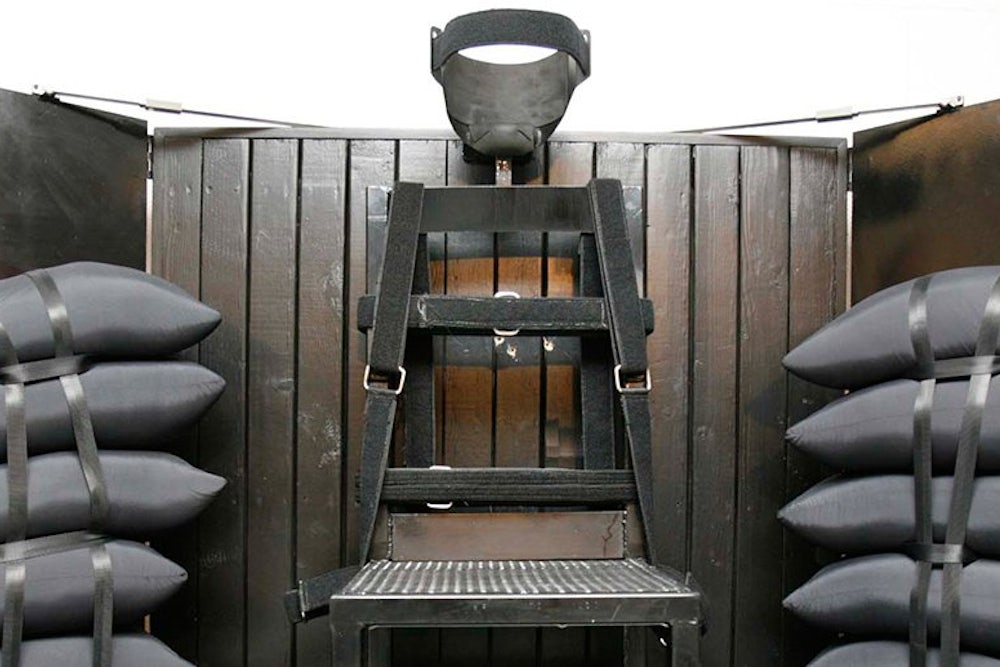In 2011, the European Union banned the export of lethal injection drugs to the United States in an effort to save America from itself. The reasoning behind the embargo was queasily naïve: Without the drugs, European legislators reasoned, American officials would be at a loss to carry out executions, and the practice would perhaps come to an end. Though the ban did slow the rate of American executions, it now seems Europe’s humanitarians underestimated old-fashioned American ingenuity. On Monday, Utah’s governor Gary Herbert signed a bill into law that will allow firing squads to be used in place of lethal injections should the drugs be unavailable.
Figuring out how to kill people during drug shortages has spurred several states to expand their execution laws. Like Utah, Oklahoma also permits firing squads; meanwhile, a slew of southern states including Kentucky, Tennessee, and Alabama still allow electrocution. In New Hampshire, inmates can be hanged, while California and Arizona offer the gas chamber. As time wears on and stocks of lethal drug cocktails continue to dwindle, these methods of killing, once ostensibly consigned to the annals of history, will doubtlessly emerge again into public discourse as reasonable and necessary provisions.
Indeed, as Herbert signed Utah's new law, modest proposals on behalf of the firing squad arrived. Bloomberg’s Matt Stroud laid out experts' case for firing squad executions, pointing out that “If the firing squad is gruesome, lethal injection isn't necessarily humane.” Firing squad executions, Stroud reports, can be botched as surely as executions by lethal injection, and neither method is guaranteed to be painless or consistently uncomplicated. At the Washington Post, Terrence McCoy presented a similar analysis: While an inmate might flinch or a rifleman might miss, “it’s substantially easier to find competent executioners who know how to correctly operate a rifle than a syringe.” If done properly, McCoy concludes, based on a 1993 study, death by a bullet in the heart is less painful than the alternatives.
Comfort does not come any colder. It is the year 2015, and we Americans are idly musing about what particular methods kill people most harmlessly. There probably are, as Stroud and McCoy suggest, only miniscule differences in suffering when most viable methods are carried out precisely, because life is fragile and relatively easy to snuff. The bizarre reality, then, is that we are content to argue about the last two or three minutes of a person’s life, when the entire procedure of a death sentence is an experiment in torture.
The average prisoner on death row has spent more than ten years in captivity awaiting death. Some inmates wait decades to die. In this time, inmates often are subject to the uncertainty of appeals and execution stays, anxiously suspended from false hopes and distant mercy, and are often kept in dreary isolation. The combination of these factors sometimes produces a psychological syndrome known as “death row syndrome” or “death row phenomenon,” a manmade mental illness with symptoms ranging from self-harm to psychosis to suicide. For these reasons, American legal authorities, including Supreme Court Justice Stephen Breyer, have deemed the lengthy periods spent awaiting execution akin to cruel and unusual punishment.
Even if inmates marked for death spent less time counting down to execution, the practice would still be intolerably inhumane, the equivalent of an unwavering daily death threat. All of us are subject to the distress of knowing we will inevitably die. But inmates on death row face a timeline foreshortened and intensified by isolation from family, friends, and other sources of meaning. Furthermore, many of the apparatuses we in free society use to soften our approach to death—like doctors, pastors, and counselors—are rendered essentially powerless in the face of the death penalty. Doctors serving the condemned are, paradoxically, unable to stave off death, while pastors and priests are not able to intercede for mercy. Because these agents are, in prison settings, employed by the state to facilitate the execution process, inmates have little to gain from their intervention aside from some meager comfort and the dreadful sensation that arises in nightmares when familiar figures and sources of comfort are made monstrous and foreign.
The debate over particular death penalty methods obscures the cruelty of the entire scheme. It is difficult to explain why we should be concerned about the distress and pain a person might feel as we kill them, but not with the distress and pain they endure living with the knowledge that we will kill them for days, weeks, months, and years. Worse, as public discourse centers more tightly on methods and less on the overarching brutality of the death penalty as an institution, we numb ourselves to the fact of execution by obsessing over its particularities. With each passing year, stocks of lethal chemicals erstwhile considered humane will continue to diminish, and formerly unthinkable methods of killing will again seem reasonable and perhaps even superior, and each time we come to these conclusions, we will become a crueler nation.
